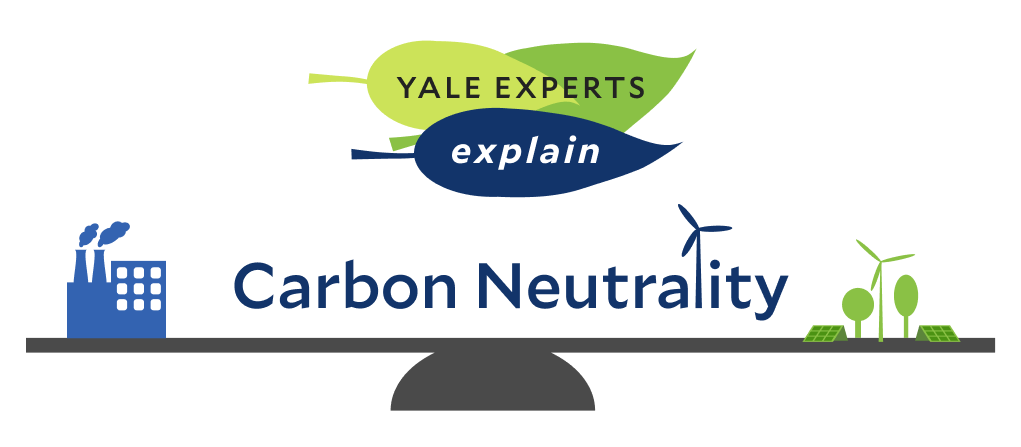
April 18, 2020
Climate scholars Ken Gillingham, Peter Boyd, and Brad Gentry offer their insight into what carbon neutrality means and what it might take to achieve net-zero emissions.
What is carbon neutrality?
“Carbon neutrality means net zero carbon,” says Ken Gillingham, Associate Professor of Economics. “This means that any actions that lead to emissions would be accompanied by other actions that confidently reduce – or offset – emissions.”
In contrast to ‘net zero carbon’, Gillingham explains that ‘zero carbon’ means having no emissions at all – something he deems to be impossible in today’s society – and ‘carbon-positive’ means that you sequester more carbon emissions than you emit.
Peter Boyd, Resident Fellow at the Center for Business and the Environment and Mentor-in-Residence at the Tsai Center for Innovative Thinking, states that carbon neutrality is not about “achieving absolute zero” but instead “reducing our human-caused emissions to the level where the natural world has an ability to absorb it so we can observe a planet in an equilibrium.”
To simplify it, Boyd likes to think of carbon neutrality like living on a campsite. “We, as human hikers, want to leave the campsite as good as we found it,” Boyd says. “That means that the water flowing upstream is just as good as the water flowing downstream of our campsite.”
What are the benefits of going carbon neutral?
Brad Gentry, the F.K. Weyerhaueser Professor in the Practice of Forest Resources Management and Policy, explains that becoming carbon neutral is “part of our civic responsibilities, as a large part of the solution to climate change is going to be reducing emissions.”
In addition to helping to mitigate “dire weather changes”, Gentry says that moving towards carbon neutrality offers co-benefits such as reduced air pollution and increased resiliency of buildings, not to mention reduced energy bills. However, Gillingham believes that the research and teaching opportunities made available to “both young scholars and the world” through pursuing carbon neutrality is the goal’s biggest environmental impact. “Small changes taking place at a small institution or company [like Yale] alone aren’t going to solve climate change,” Gillingham says. “But setting an example and having others follow will help move the needle forward in a way that might actually make a difference.”
How do you achieve carbon neutrality?
To Boyd, meeting a carbon neutrality goal starts with “taking full responsibility of all of one’s [direct and indirect] emissions” and “owning the responsibility for the reductions.” On the ground, these reductions can take the form of building retrofits, low-to-no carbon emitting building designs, and a move toward renewable energy. However, these actions each involve a number of trade-offs, and are expensive, time-consuming, disruptive, and in many cases, currently impossible.
Boyd explains that responsible industries and institutions can strive to become more and more efficient, but at one point in time, they will inevitably reach a ‘gap’ between the goal of carbon neutrality and what is financially and technologically possible. For this reason, Gentry says that becoming carbon neutral takes “a combination of reducing your own emissions and investing in other emission reductions wherever you can find them, particularly ones that wouldn’t happen otherwise.” These investments are called carbon offsets – the certified reduction in emissions in one place that compensate for emissions in another. Gentry explains that these can take the form of emission reduction projects, like capturing methane at a landfill site, or carbon sequestration projects, such as planting trees or protecting forests that absorb carbon.
What happens after we achieve neutrality?
For our experts, achieving carbon neutrality for one’s current emissions is not the end-goal, but rather a bridge to more substantial reductions. Boyd explains that the next step for ambitious industries and institutions is to make carbon neutrality efforts “cumulative”, thereby making up for all emissions ever emitted. “You wouldn’t go in and eat at a restaurant for years and then only suddenly start paying the bill,” Boyd said. “Before we can claim ourselves to be net-zero and a benign force on the planet, we should settle up our tab.”
What can an individual do?
“The power of net-zero is that it can work on every level,” Boyd says. “It can work on the global level, a country level, a community or company level, and even at an individual level.” While a carbon neutral world remains a hefty goal, our experts agree that individuals can move toward their own net-zero lifestyle by making efforts to reduce your energy and water consumption, keep an eye on the food you eat and the waste you produce, the amount you travel, and offsetting your travel and activities when possible.
What is Yale Doing?
In 2005 Yale set a goal of reducing greenhouse gas emissions by 43% by 2020, and in 2021, Yale committed to reaching net zero emissions by 2035 and achieving zero actual carbon emissions by 2050. Net zero will be attained by reducing campus emissions to 50% of 2005 levels and purchasing high-quality verifiable carbon offsets. Zero actual carbon emissions will be accomplished by fully minimizing campus emissions.